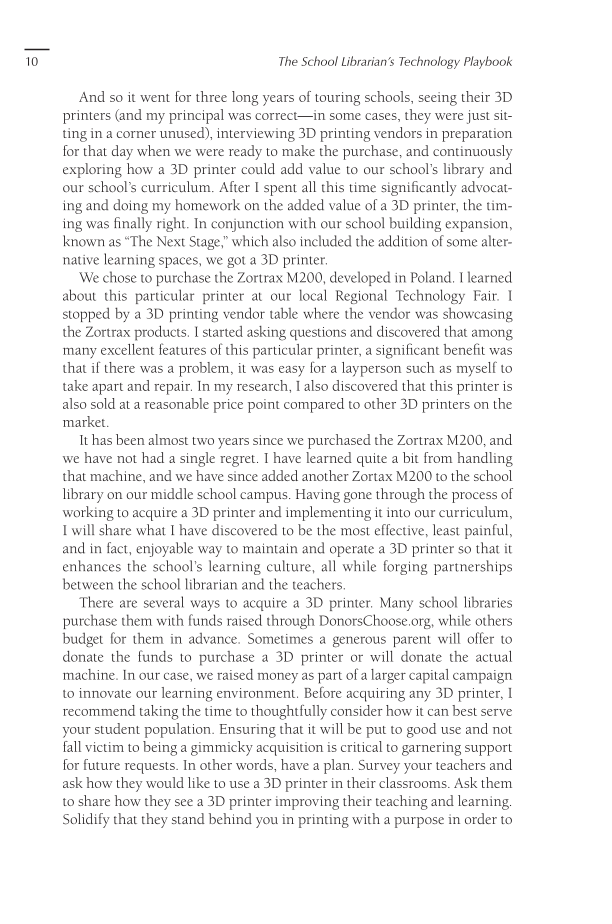10 The School Librarian’s Technology Playbook And so it went for three long years of touring schools, seeing their 3D printers (and my principal was correct—in some cases, they were just sit- ting in a corner unused), interviewing 3D printing vendors in preparation for that day when we were ready to make the purchase, and continuously exploring how a 3D printer could add value to our school’s library and our school’s curriculum. After I spent all this time significantly advocat- ing and doing my homework on the added value of a 3D printer, the tim- ing was finally right. In conjunction with our school building expansion, known as “The Next Stage,” which also included the addition of some alter- native learning spaces, we got a 3D printer. We chose to purchase the Zortrax M200, developed in Poland. I learned about this partic u lar printer at our local Regional Technology Fair. I stopped by a 3D printing vendor table where the vendor was showcasing the Zortrax products. I started asking questions and discovered that among many excellent features of this partic u lar printer, a significant benefit was that if there was a problem, it was easy for a layperson such as myself to take apart and repair. In my research, I also discovered that this printer is also sold at a reasonable price point compared to other 3D printers on the market. It has been almost two years since we purchased the Zortrax M200, and we have not had a single regret. I have learned quite a bit from handling that machine, and we have since added another Zortax M200 to the school library on our middle school campus. Having gone through the process of working to acquire a 3D printer and implementing it into our curriculum, I will share what I have discovered to be the most effective, least painful, and in fact, enjoyable way to maintain and operate a 3D printer so that it enhances the school’s learning culture, all while forging partnerships between the school librarian and the teachers. There are several ways to acquire a 3D printer. Many school libraries purchase them with funds raised through DonorsChoose . org, while others budget for them in advance. Sometimes a generous parent will offer to donate the funds to purchase a 3D printer or will donate the actual machine. In our case, we raised money as part of a larger capital campaign to innovate our learning environment. Before acquiring any 3D printer, I recommend taking the time to thoughtfully consider how it can best serve your student population. Ensuring that it will be put to good use and not fall victim to being a gimmicky acquisition is critical to garnering support for future requests. In other words, have a plan. Survey your teachers and ask how they would like to use a 3D printer in their classrooms. Ask them to share how they see a 3D printer improving their teaching and learning. Solidify that they stand behind you in printing with a purpose in order to
Document Details My Account Print multiple pages
Print
You have printed 0 times in the last 24 hours.
Your print count will reset on at .
You may print 0 more time(s) before then.
You may print a maximum of 0 pages at a time.

























































































































































































































































